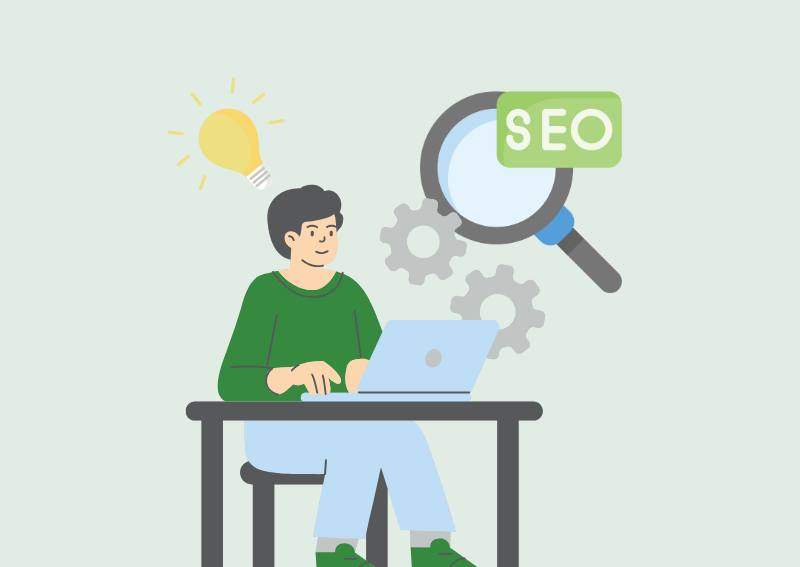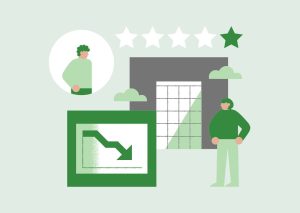
What is the Difference Between On-Page and Off-Page SEO?
Search engine optimisation (SEO) has a lot of layers, but there are two main areas: on-page and off-page SEO.
On-page SEO is everything you control directly on your website—like content, structure, and technical details. Off-page SEO, on the other hand, happens outside your site and focuses on building trust, credibility, and recognition across the web.
Both sides are crucial for making your website more visible but each plays different roles. Whether you’re managing SEO yourself or working with a digital marketing agency, understanding these areas is key to building a strong foundation that drives meaningful traffic to your site.
Below, we’ll explain the difference between these areas and techniques to make them work for your website.
What is on-page SEO?
On-page SEO is all about fine-tuning the parts of your website that you control directly–from the content you create to how your pages are structured.
The goals here are twofold:
- to create a great user experience
- to help search engines understand what your content is all about
When your website is easy to navigate, loads quickly, and provides valuable information, it pleases your visitors and, at the same time, sends positive signals to search engines. This helps your site show up higher in search results.
In other words, when done right, on-page SEO makes it easier for people to find, engage with, and return to your site, ultimately driving more meaningful traffic that supports your business goals.
Elements of On-Page SEO
The essential elements of on-page SEO can be categorised into three: Content Optimisation, Technical Optimisation, and User Experience (UX). Together, these elements form the backbone of making your website search engine- and user-friendly.
Content Optimisation
Content optimisation focuses on creating high-quality, relevant, and informative content for your audience. To achieve this, you must focus on four key elements:
- Information. Ensure your content answers the needs and questions of your audience.
- Keywords. Conduct research and place keywords strategically to improve search visibility. This is called writing for SEO.
- Structure. Use clear headings, bullet points, and formatting to enhance readability and flow.
- Images. Add images to make your content visually engaging and optimise images with descriptive alt text to make content more accessible.
Technical Optimisation
Technical optimisation involves refining the behind-the-scenes elements of your website that impact search engine rankings. Key areas to focus on include:
- Website speed and performance. This ensures users enjoy a fast and seamless browsing experience.
- Mobile-friendliness. This refers to optimising your site for viewing on any mobile device, like smartphones and tablets.
- URL structure. This area refers to using clear, optimised URLs that help search engines and users understand each page’s content. The section on On-page SEO Techniques discusses tips for optimised URLs.
- Schema markup. This adds additional information for search engines, improving visibility in search results.
- XML sitemap. This guides search engines in navigating and indexing your site effectively.
User Experience
User experience is the intersection of SEO and usability. Its elements include easy navigation and structure, clear calls to action, and accessibility.
- Ease of navigation and structure. A well-organised site helps visitors find what they’re looking for quickly and effortlessly.
- Clarity of calls to action. This guides users toward actions like reading more, subscribing, or purchasing.
- Accessibility. An accessible website ensures all users, including those with disabilities, can interact with and understand your site. This makes your site more inclusive—an increasingly important factor that search engines recognise as part of a positive user experience.
On-Page SEO Techniques
Now that you know the key elements of on-page SEO, let’s discuss the techniques that bring them to life on your website. These strategies will help you attract more visitors and keep them engaged:
Keyword Research
The foundation of any SEO strategy is solid keyword research. Find keywords relevant to your audience, have a high search volume, and face minimal competition. Focusing on these keywords will improve your chances of reaching users actively searching for what you offer.
Content Optimisation
Content optimisation is about creating content that’s truly valuable, informative, and engaging. When your content speaks to readers’ needs, keeps them interested, and is well-organised, it improves user experience and strengthens your SEO.
Title Tag Optimisation
Your title tag is a key factor in how your page appears in search results. Craft each title tag to be clear, informative, and enticing, making sure to include your target keywords. A well-optimised title not only catches the eye but also boosts your page’s relevance.
Meta Description Optimisation
Meta descriptions are your chance to make a strong first impression. Write concise, persuasive descriptions that summarise your page and encourage clicks. A well-written meta description can be the difference between a user clicking through to your site or scrolling past.
Header Tag Optimization
Header tags (H1-H6) organise your content, guiding readers and search engines through your main points. Using these tags effectively makes your content more readable and helps search engines understand the structure and relevance of each section.
Image Optimisation
Optimised images are essential for a fast, accessible website. Compress images to improve load times, and add descriptive alt text to give search engines context for your visuals. This enhances accessibility and adds another layer of SEO value to your content.
Internal Linking
Internal links are an easy but powerful way to improve SEO and user experience. Link to related content within your site to keep visitors exploring and to help search engines map out the relationships among your pages. Each link strengthens your site’s structure and flow.
Note: To truly maximise these strategies, you should have an understanding of how search engines work and how they evaluate your website.
What is Off-Page SEO?
Off-page SEO includes all the actions that happen outside your website that affect how well you rank in search results. While you can’t directly control these factors like you can with on-page SEO, they play a massive role in how search engines view your site’s credibility and authority.
Although these factors happen outside your website, you’re not entirely at their mercy. With the right strategies, you can positively influence how others perceive and interact with your brand online.
The following sections explore crucial elements to focus on and practical techniques to make each one work to your advantage.
Elements of Off-Page SEO
To succeed in off-page SEO, focus on the following core elements:
Backlinks
Backlinks—links from other websites that point to yours—are one of the most essential elements of off-page SEO. When reputable sites link to your content, it signals to search engines that your site is trustworthy and relevant.
Social Media Engagement
While social media signals don’t directly impact rankings, a robust presence can still support your SEO efforts. When your content is shared widely on social platforms, it reaches more people and increases the chances of earning valuable backlinks and traffic to your site.
Social engagement also helps to build brand awareness and credibility. The more people know about you, the more traffic you can get, which ultimately sends a positive signal to the search engine about your site’s authority.
Brand Mentions
When people mention your brand online, even if it’s not linked directly to your site, it can still positively impact your off-page SEO. Search engines can recognise unlinked brand mentions, which can add to your site’s trustworthiness and reputation.
Influencer and Partnership Outreach
Collaborating with influencers or industry partners can boost your site’s reputation and authority. When a well-respected figure in your field shares or links to your content, it can create a powerful endorsement that builds credibility for your site.
Forum and Community Participation
Actively participating in online forums and communities relevant to your industry can also enhance your off-page SEO. Platforms like Reddit, Quora, and industry-specific forums allow you to engage with a broader audience, answer questions, and share your expertise. Just remember to provide genuine value, as forums reward helpful contributions over self-promotion.
Off-Page SEO Techniques
Now that you know the elements, here are some proven techniques for effective off-page SEO:
Link Building
When link building, focus on acquiring high-quality backlinks from reputable sites. Look for opportunities with sites with strong domain authority relevant to your industry.
Note that quality is key here; a few high-quality backlinks from authoritative sites are far more valuable than many links from less credible sources.
These are some proven ways to get backlinks:
- Guest posting. Write high-quality guest posts for reputable industry sites with a link back to your content.
- Content-based link building. Create valuable, share-worthy resources like guides, infographics, and original research that other sites naturally want to link to.
- Broken link building. Find broken links on reputable sites in your industry, then reach out and suggest your content as a relevant replacement.
- Resource page outreach. Connect with sites that list useful resources in your field and suggest your site for inclusion.
Social Media Marketing
Share your content on platforms where your audience is most active. Make it beneficial for them so it naturally encourages engagement through comments, shares, and likes. Each interaction strengthens your brand’s presence.
Here are some tips to increase engagement:
- Develop visually engaging and informative content—like infographics, short videos, or checklists—that followers want to share.
- Stick to a regular posting schedule on the platforms where your audience is most active.
- Actively respond to comments and messages to encourage two-way communication and build stronger connections.
- Run campaigns that invite followers to create and share content about your brand, widening your reach. This is called user-generated content.
Read our social media marketing guide for more tips.
Brand Mentions
Use tools like Google Alerts or social media monitors to track where your brand is mentioned, then engage with these mentions to build relationships.
If no one has mentioned your brand yet, try:
- Pitching stories, press releases, or updates about your brand to journalists and bloggers for added exposure
- Encouraging satisfied customers to leave reviews on platforms like Google My Business, Yelp, Trust Pilot and others
Influencer Marketing
Find influencers who align with your brand and collaborate on content that showcases your expertise. Then you can either:
- Partner on blog posts, videos, or podcasts that showcase your expertise to both audiences or
- Offer product samples to influencers in exchange for an honest mention or review to build brand awareness
Forum and Community Participation
In forums, people are looking for genuine advice—not advertisements. So, ensure:
- Your focus is on offering helpful answers, practical tips, or insights that add value to the conversation. When you have an article, blog post, or resource that directly answers a question or adds to the discussion, include a link if allowed by the forum moderators.
- Regular participation in discussions, offering advice and answering questions. A consistent presence allows you to become a familiar face, which builds trust over time and encourages users to check out your content or website.
- Responsiveness to comments, follow-up questions, and feedback. This active engagement shows you’re committed to the community and open to dialogue.
For more SEO insights, read our Ultimate Guide to SEO. Our guide covers all the essential topics to boost your website’s visibility, from keyword research to link building.
On-Page vs Off-Page SEO: What to Prioritise
Ideally, you should work on both simultaneously when deciding between on-page and off-page SEO. These two aspects of SEO complement each other and are equally crucial to boosting your search engine ranking.
But if you are a one-person team or working with limited resources, start with on-page SEO. Focusing on on-page elements ensures your site is fully optimised for search engines and user-friendly for visitors. It’s also the part of SEO you have the most direct control over, so improving your site’s content, structure, and usability can deliver quick wins.
Once you’ve optimised your on-page elements, you can shift your focus to off-page techniques to increase your website’s authority and broaden its reach. By building a solid base with on-page SEO, you set yourself up for success when you’re ready to dive into off-page efforts.
Ready to boost your website ranking? Partner with the leading SEO agency in Melbourne and across Australia today. Contact us or start with a free SEO audit.


